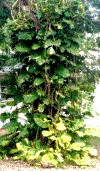Epipremnum aureum Keratopathy: Case Report and Review of the Literature
- PMID: 31794541
- PMCID: PMC7255961
- DOI: 10.1097/ICL.0000000000000675
Epipremnum aureum Keratopathy: Case Report and Review of the Literature
Abstract
Objectives: To report a novel case of Epipremnum aureum toxicity masquerading as bilateral infectious keratitis and review the literature on ocular manifestations of Epipremnum exposure.
Methods: Case report and literature review.
Results: A 70-year-old man with a history of photorefractive keratectomy presented with a 3-day history of bilateral eye pain. The patient reported exposure to plant debris while performing yard work and also water exposure while cleaning his coral fish tanks. Clinical examination revealed bilateral epitheliopathy progressing to frank epithelial defects with underlying stromal necrosis 6 days after exposure. Empiric topical antibiotic drops were initiated, but multiple cultures, corneal biopsy, and confocal microscopy were all negative for an infectious agent. Over a 2-week period, the epithelial defects worsened and a suspicion for a toxic etiology was raised. The patient later recalled rubbing his eyes after exposure to Epipremnum aureum (Golden Pothos/Devils Ivy) sap. He was thus treated conservatively with artificial tears, topical corticosteroids, and amniotic membrane. After 3 months, the epithelial defects resolved, but with corneal scarring, prominently in the left eye and underwent penetrating keratoplasty. Five years after presentation, best-corrected visual acuity with hard contact lenses was 20/25 in the right eye and 20/20 in the left eye.
Conclusion: Epipremnum aureum toxicity is a rare cause of keratitis. It can mimic acanthamoeba keratitis or anesthetic abuse and should be considered in cases of culture negative nonhealing corneal ulcerations. Eliciting a history of plant sap exposure can facilitate appropriate supportive care for this toxic keratitis.
Conflict of interest statement
The authors declare that there is no conflict of interest.
Figures






References
-
- Slaughter RJ, Beasley DM, Lambie BS, et al. Poisonous plants in New Zealand: a review of those that are most commonly enquired about to the National Poisons Centre. N Z Med J. 2012; 125(1367): 87–118. - PubMed
-
- Dutta J, Choudhury S, Lahiri K, et al. Penetrating keratoplasty restoring vision in an unusual case of corneal opacity following exposure to Euphorbia latex. Trop Doct. 2015; 45(4): 239–40. - PubMed
Publication types
MeSH terms
Grants and funding
LinkOut - more resources
Full Text Sources
Miscellaneous

